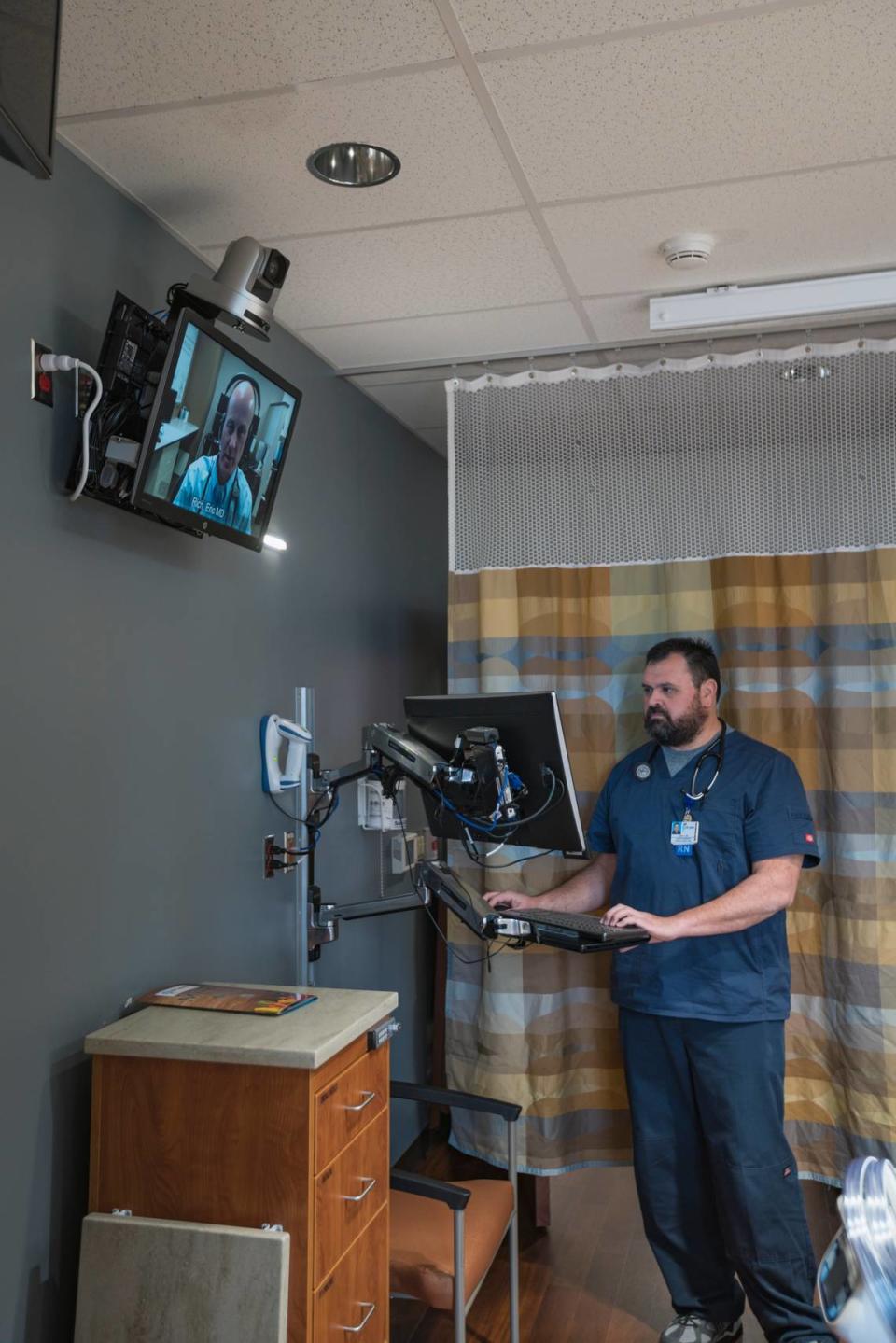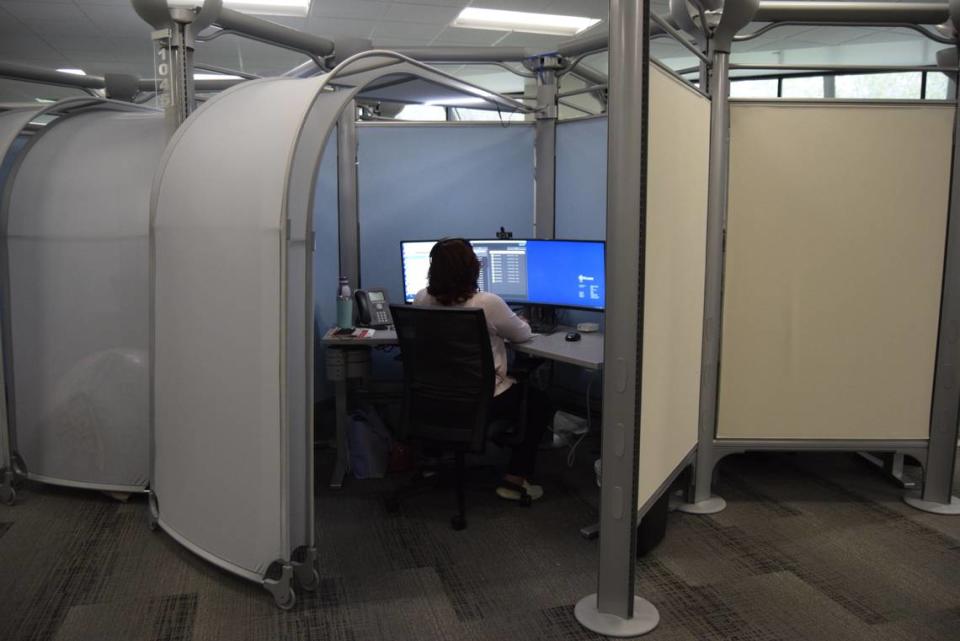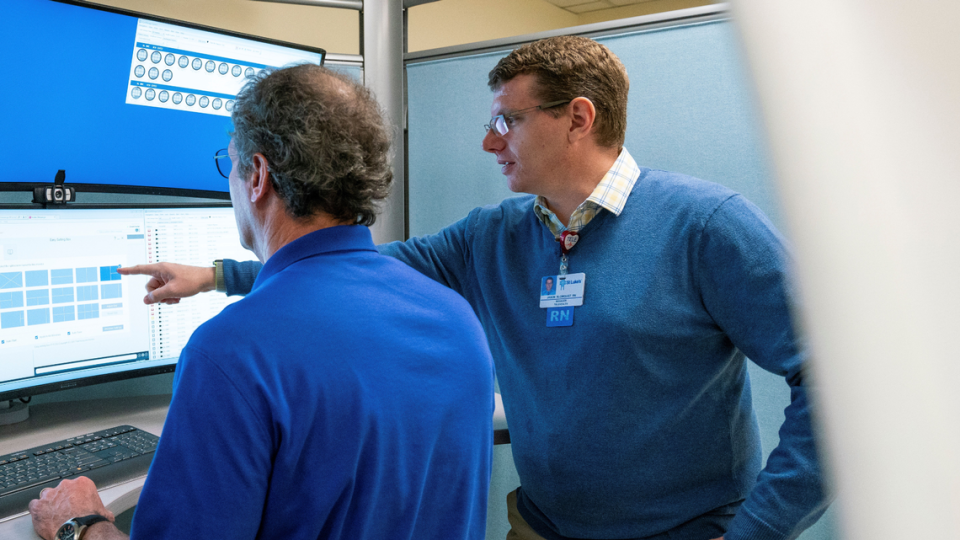You’re in a hospital room. Suddenly a nurse appears on a screen overhead. What’s going on?
If you’ve been admitted to a hospital in the last few years, or even visited, you may be familiar with an increasingly ubiquitous part of patient care: virtual nursing. It involves a friendly face checking in via a bedside computer screen. To some, it may come as a surprise.
But it’s now business as usual at the two biggest health systems in Idaho.
St. Luke’s and Saint Alphonsus health systems have gradually adjusted the way their staffs deliver patient care to maximize efficiency amid industry-wide labor shortages — not unlike many hospitals across the country.
That includes using cameras and microphones to tend to patients remotely, even from other, nearby areas of the hospital.
It’s not a replacement for in-person care, the health systems say, but is designed to assist bedside nurses in performing rudimentary tasks like reviewing a patients’ vitals, discussing their medication, ordering them food or coordinating an appointment.
“We try to free our nurses up to do the things that they need to do at the bedside, while we do all those other things virtually,” said Cynthia Stevenson Newsom, director of telehealth at St. Luke’s.
Newsom said the technology is used at all of the health system’s hospitals.
‘Longstanding history of telehealth’
St. Luke’s had already been using cameras and microphones for about a decade but has used them more frequently since 2019, particularly when the COVID-19 pandemic made it more challenging to treat patients.
“We have a longstanding history of telehealth inside the hospital,” Newsom said.
The health system developed a program 10 years ago inside its Boise Medical Center that allows virtual nurses to support bedside nurses in the intensive care units through video monitoring. If the bedside nurses need help, all they have to do is press a button.
The program has grown significantly in the past few years, according to Newsom.
“We are doing things today with telehealth that I couldn’t have imagined when I was in practice,” said Dr. David Pate, the former CEO of St. Luke’s, on the health system’s website.
Before the pandemic, the health system had 300 rooms that were fully equipped for virtual care. Now, over 700 are. That includes all of St. Luke’s emergency departments and intensive care units.

Saint Alphonsus also started implementing the technology less than a year ago. Leticia Ramirez, a spokesperson for the health system, said virtual care is, for now, used only in certain units, including one of its medical-surgical units. She said it is not used in high-risk areas.
But the health system is looking to eventually expand the virtual nursing model within its hospitals.
Its remote nurses are physically at the hospital, just on a different floor than the patients they’re video calling. St. Luke’s remote nurses work in a dedicated virtual-care center located off East Park Boulevard in downtown Boise. The center was established in 2018 and serves all of the health system’s hospitals and clinics.
“We’re still working through the kinks and continuing to refine it,” Ramirez said. “These are very experienced and seasoned nurses who want to continue to provide care but prefer to do it in this environment versus being on the unit.”
Staffing shortages pave way for virtual care
The shift toward virtual nursing has stemmed from a combination of things, she said, including staffing shortages and a need to maximize the skills of the personnel available.
Plus, it gives patients quicker access to care if they need it.
Newsom said that, by performing routine tasks remotely, staff members have more time to spend with each patient, even if they’re not physically in the same room. That time can be used to answer additional questions or allow for more in-depth conversations related to the person’s care.
“It cuts out that extra time and allows us to spend more time with the patient,” Newsom said.

If a patient’s bedside nurse is tied up with someone else down the hall, that patient has another, albeit virtual, nurse the patient can reach out to through a monitor for a live, two-way video call.
“Their needs are met immediately,” Ramirez said. “It basically extends a nurse’s capability to be available for other patients as the need may arise.”
Patients can opt out
Newsom said the cameras “are so good” that they can zoom in and read a patient’s armband or the label on a bottle of medication.
“The camera is like an eyeball,” she said. “It can look up, down, around.”
Newsom and Ramirez both noted that patients can choose whether or not to participate in virtual care. They said patients always has the option to see a provider in person.
“The virtual nurse can only enter the patient’s room with permission,” Ramirez said. “They don’t just zoom in unannounced. Patients can say, ‘No thank you, I’m not interested.’ But we do discuss it with them as an option.”

St. Luke’s uses a private, encrypted network for all its virtual care, which it says is “extremely secure.” The health system doesn’t record any of the interactions.
Newsom also said the technology is compliant with the Health Insurance Portability and Accountability Act of 1996, or HIPAA, and that staff is “very careful” regarding patient privacy.
“Our nurses are excellent caregivers,” Newsom said. “We’re just teaching them to how to deliver that professional need differently. Instead of walking in the door, they can beam in on the camera.”
St. Luke’s has big plans for its downtown Boise campus. Here’s what to expect
St. Luke’s takes new steps to get money owed by Ammon Bundy. Judge considers order
Idaho Medicaid, strained with ‘day-to-day operations,’ has budget request for more staff
New COVID-19 booster approved by FDA. Here’s who can get it, where it’s available in Boise

